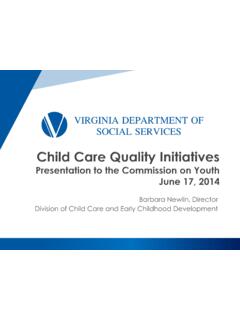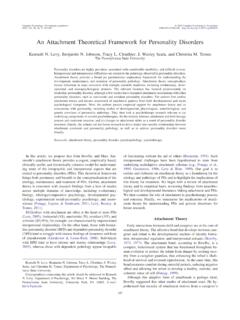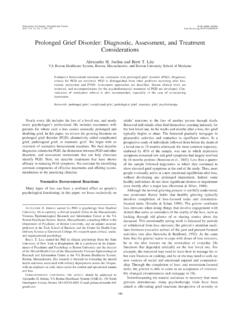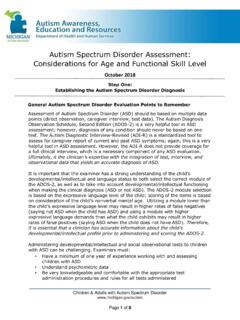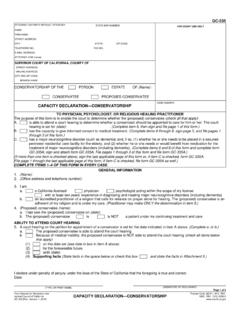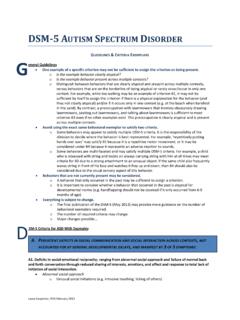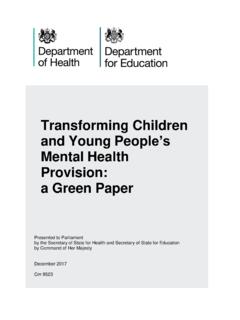Transcription of DJUSTMENT DISORDER - Virginia
1 Collection of Evidence-based Practices for Children and Adolescents with Mental Health Treatment Needs Virginia Commission on Youth, 2017 ADJUSTMENT DISORDER Introduction Recent Changes from the DSM-IV to the DSM-5 Prevalence Causes and Risk Factors Classifications Diagnosis Comorbidity Treatment Psychotherapy Pharmacological Treatment Cultural Considerations Overview for Families Introduction An adjustment DISORDER is an unhealthy behavioral response to a stressful event or circumstance (Medical Center of Central Georgia, 2002). Youth who experience distress in excess of what is an expected response may experience significant impairment in normal daily functioning and activities (Institute for Health, Health Care Policy and Aging Research, 2002). Adjustment disorders in youth are created by factors similar to those in adults.
2 Factors that may contribute to the development of adjustment disorders include the nature of the stressor and the vulnerabilities of the child, as well as other intrinsic and extrinsic factors (Benton & Lynch, 2009). In order to be diagnosed as an adjustment DISORDER , the child s reaction must occur within three months of the identified event (Medical Center of Central Georgia, 2002). Typically, the symptoms do not last more than six months, and the majority of children quickly return to normal functioning (United Behavioral Health, 2002). Adjustment disorders differ from post-traumatic stress DISORDER (PTSD) in that PTSD usually occurs in reaction to a life-threatening event and may last longer (Access Med Health Library, 2002). Adjustment disorders may be difficult to distinguish from major depressive DISORDER (Casey & Doherty, 2012).
3 Unless otherwise cited, the following information is attributed to the University of Chicago Comer Children s Hospital (2005). In clinical samples of children and adolescents, males and females are equally likely to be diagnosed with an adjustment DISORDER (American Psychiatric Association [APA], 2000). Adjustment disorders occur at all ages. However, characteristics of the DISORDER in children and adolescents are different from those in adults. Differences are noted in the symptoms experienced, in the severity and duration of symptoms, and in outcomes. Adolescent symptoms of adjustment disorders are more behavioral (for instance, acting out), while adults experience more depressive symptoms. Recent Changes from the DSM-IV to the DSM-5 The DSM-5 is a manual for assessment and diagnosis of mental health disorders and does not include information for treatment of any DISORDER .
4 In the future, more evidence supporting treatments of disorders with DSM-5 classifications will be available as clinical studies utilizing DSM-5 criteria are conducted. As 1 Adjustment DISORDER Collection of Evidence-based Practices for Children and Adolescents with Mental Health Treatment Needs Virginia Commission on Youth, 2017 a result, this Collection will reference studies that utilize DSM-IV diagnostic criteria to explain symptoms and treatments. Adjustment disorders are part of the Trauma and Stressor-Related disorders section of the DSM-5. In the DSM-IV, adjustment disorders were characterized as clinically significant distress not categorized by another DISORDER . The DSM-5 recategorizes adjustment disorders as a heterogeneous array of stress response syndromes that occur after exposure to a distressing (traumatic or nontraumatic) event (APA, 2013).
5 Prevalence Adjustment DISORDER prevalence varies depending upon the population studied and the method used in that study. Of individuals undergoing outpatient mental health care treatment, 5 to 20 percent are diagnosed with an adjustment DISORDER . Individuals in a psychiatric hospital setting have a prevalence rate as high as 50 percent (APA, 2013). This data represents individuals of all ages. At this time, there are no official figures representing prevalence rates in youth. However, in 1997, the Department of Health and Human Services, the Substance Abuse and Mental Health Service Administration (SAMHSA), and the Center for Mental Health Services conducted a client/patient sample survey of 8,000 children in mental health facilities. These children were randomly selected and surveyed in order to calculate national estimates of mental health services.
6 The findings of the study indicated that 16 percent of the children who were admitted had an adjustment DISORDER (Institute for Health, Health Care Policy and Aging Research, 2002). Causes and Risk Factors Adjustment disorders are a behavioral or emotional reaction to an outside stressor. Because children possess varying dispositions, as well as different vulnerabilities and coping skills, it is impossible to attribute a single explanation as to why some stressors trigger adjustment disorders in some children and others do not (Medical Center of Central Georgia, 2002). However, experts have found that the developmental stage of the child and the strength of the child s support system influence their reaction to the stressor (Medical Center of Central Georgia). One common trigger for adjustment DISORDER includes grief and bereavement, especially following the death of a family member or sibling (Machajewski & Kronk, 2013).
7 There is no evidence to indicate that biological factors influence the cause of adjustment disorders ; the most widely accepted thought is that stress itself is the precipitating factor (Benton & Lynch, 2009). According to Benton and Lynch (2009), an important factor in the development of an adjustment DISORDER is the vulnerability of the child. Vulnerability depends on the characteristics of both the child and the child s environment. The DSM-5 notes that individuals in disadvantaged life circumstances experience a high stressor rate and, as a result, may be at greater risk for developing adjustment disorders (APA, 2013). Classifications According to the University of Chicago Comer Children's Hospital (2005), in adjustment disorders , a child s reaction to the stressor is beyond a normal reaction or significantly interferes with social, occupational, or educational functioning.
8 In adults, there are six subtypes of adjustment DISORDER , based on the major symptoms experienced. However, clinical symptoms in children and adolescents differ from those in adults (Benton & Lynch, 2009), and there may be a predominance of mixed, rather than discrete, symptom presentations (Newcorn & Strain, 1992). Research has also suggested that more serious mental health disorders were present in children and adolescents after five years of follow-up (Andreasen & Hoenk, as cited by Benton & Lynch). 2 Adjustment DISORDER Collection of Evidence-based Practices for Children and Adolescents with Mental Health Treatment Needs Virginia Commission on Youth, 2017 Table 1 Adjustment DISORDER Subtypes Subtype Key Characteristics Symptoms With depressed mood Symptoms are that of a minor depression Depressed mood; tearfulness; feelings of hopelessness With anxiety Symptoms of anxiety are dominant Nervousness; worry; jitteriness.
9 Fear of separation from major attachment figures With depressed mood and anxiety Symptoms are a combination of depression and anxiety Combination of symptoms from both the above subtypes With disturbance of conduct Symptoms are demonstrated in behaviors that break societal norms or violate the rights others Violation of the rights of others and/or societal norms and rules; truancy; destruction of property; reckless driving; fighting With mixed disturbance of emotions and conduct Symptoms include combined affective and behavioral characteristics with mixed emotional features and a disturbance of conduct Combination with depressed mood and anxiety and with disturbances of conduct Unspecified Maladaptive reaction is not classified under other adjustment disorders but occurs in response to stress Reactions to stress that do not fit into other subtypes Source: APA, 2013.
10 Diagnosis Because most features of adjustment disorders (such as the stressor, the maladaptive reaction, the accompanying mood and feature, and the time and relationship between the stressor and the response) are subjective, these disorders can be particularly difficult to diagnose (Benton & Lynch, 2009). The DSM-5 has specific diagnostic criteria in order to properly diagnose individuals with an adjustment DISORDER . These criteria include: Emotional or behavioral symptoms that are in response to an external stressor; Stress that is un-proportional to the stressor; Stress-related symptoms do not meet the criteria for another DISORDER ; and Symptoms do not last longer than six months after stressor is removed (APA, 2013). A qualified mental health professional should assess a child suspected of having an adjustment DISORDER following a comprehensive psychiatric evaluation and interview with the child and the family (Medical Center of Central Georgia, 2002; Carta, Balestrieri, Murru, & Hardoy, 2009).



